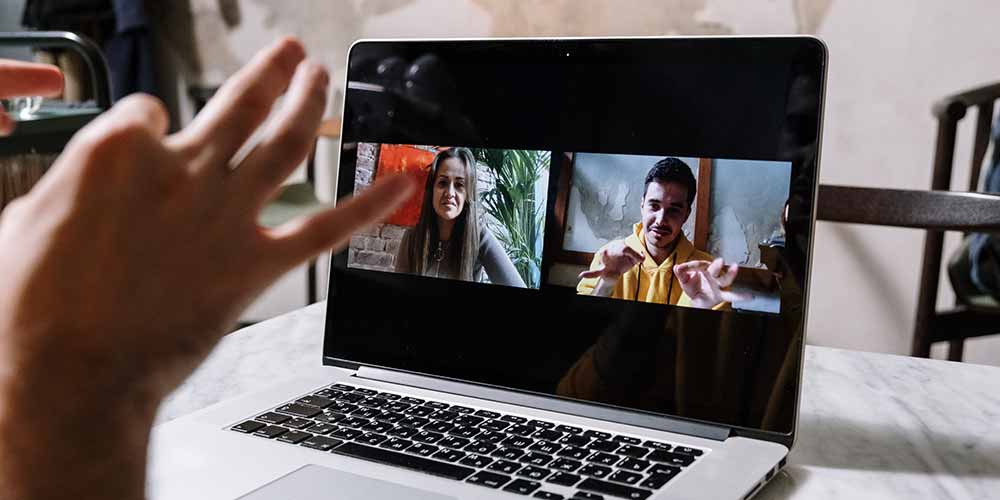How to make video meetings feel face-to-face
The typical vicious circle of poor video meetings
Hybrid organisations are scrambling to work out how to make video meetings feel face-to-face. That’s because our new world of work is hybrid and, at the centre of getting business done today, is the ubiquitous video meeting. You know the drill by now! You and your colleagues are on your webcams. All you can see is an array of postage stamp faces staring forwards.
Managing the expectations, participation and conversation flow among you is fraught with challenges. But there are opportunities too for those willing to lean into this new technology and acquire the skills needed to improve your video meetings. This briefing is focused on how to make every day video meetings both more productive and more enjoyable.
New technologies need new social norms
With each new technology invented, there is the need for people to adapt to its particular features in order to access its benefits. For example, in the early 19th century, users of the newly invented telephone didn’t know how to greet each other. They couldn’t see the other person. They didn’t necessarily know the person’s age, gender, status or context. This clashed with the expected norms of the era where hierarchies and social roles affected everything, even a greeting.
The solution, urged by Thomas Edison himself, was to adopt the socially neutral word ‘hello’. Up until then ‘hello’ was not especially common and tended to indicate surprise. Thus, social behaviour adjusted to accommodate the new technology of the telephone.
In a similar way, there is a need for those using video meeting platforms to adjust how they run a typical meeting in order to minimise the known problems and maximise the clear opportunities. If the challenges are not addressed, there is a common vicious circle where poor video meetings lead to fatigue, stilted conversations, reduced productivity and a damaging sense of disconnection and personal isolation.
Source of these problems
One reason video meetings produce fatigue and a lack of connection is because they disrupt many of the nuances of face-to-face social interaction. For example, eye contact is known to play a crucial role in any interaction. In a video meeting, these normal ‘gaze shifts’ from one person to another can’t easily be followed.
The rhythm of conversation is often less fluid, with transition times at the point of turn exchanges being longer and often more stilted than in a face-to-face meeting. There’s the common: “Sorry! You go ahead!” “No, it’s okay, over to you!”
Finally, and most importantly, our UGM research has highlighted that the small video headshot windows and muted microphones cannot readily accommodate all the vital back-channelling behaviours (nods, murmurs, small gestures) that are typically found in face-to-face interactions. These back-channel signals are important because they help to orchestrate the conversational flow and build a sense of rapport among meeting participants.
A partial solution
Some new responses have emerged to at least partially address these issues. For instance, Zoom and Teams now have response buttons that you can use to convey reactions such as approval, via an emoji. This emoji appears on the user’s video as a superimposed image.
But there is a cognitive load attached. You have to search for the button you want (its location varies by platform). Then select it and click it. It isn’t physically part of you but It’s better than nothing. It definitely lacks the human, spontaneous dimension that underpins successful communication.
A better way forward
A team at University College London (UCL) wanted to investigate a different approach. The researchers work in the Eye Think Lab in the Faculty of Brain Sciences, led by Dr Daniel Richardson. Their work focuses on the links between thinking and seeing, in the social realms of work and learning. Inspired by Edison, they wanted to know what would happen if they adapted a pre-existing, known, universal behaviour to suit the new technology of video meetings.
In their experiments, they used a communication technique that is widely thought to predate spoken language itself: gesture.
They developed a system of 12 video meeting hand signals that can easily be taught and then employed during everyday video meetings to improve meeting outcomes and meeting experience.
This ‘hand signals’ approach tackles the core problem in the majority of video meetings. People simply don’t get enough of a reaction from others. So, they start to contribute less and become uninterested. They don’t know if others are even listening to them. Maybe colleagues are doing something else? Maybe some people are even attending a different meeting at the same time!
So, the person begins to multitask too. This of course only serves to magnify the problem. Everyone starts to feel trapped in a demoralising cycle of too many unsatisfactory meetings.
The fact that so often meetings are not well chaired, have poor agendas, little or no preparation and tend to overrun makes it all worse! As one of the UCL research team commented, “It’s exhausting, unsatisfactory and not good for well-being.” Then everyone takes their stress to the next meeting!
More about these hand signals
Using video meeting signals tackles head-on this key problem of getting no reaction from others. The signals allow everyone to communicate their views, reactions and emotions in real time. The set of a dozen signals include ones that involve putting your hand on your heart to signify empathy; thumbs up or down to show agreement or disagreement; putting your hand on your head to convey you want to ask a question. There are also signals that support better chairing of meetings, such as signals for: I’d like to speak; I have a question; I have a different view; I’m not sure about that; I’d like to build on that last point – and so on.
The researchers set up an experiment with teams operating in different conditions: hand signals; emojis; or nothing. The hand signals group outperformed the others in terms of efficiency and a sense of connection and satisfaction. The team concluded that there is something about gestures and their human physicality that appears to help online interaction by conveying nuances of meaning swiftly. The impact of engaging in a physical action yourself or seeing this performed by others is powerful. Those in the hand signals group reported:
- improved engagement
- better connection
- more enjoyment of meetings
- improved productivity leading to shorter meetings
- higher quality discussions with wider participation and more inclusion
Video meeting signals that support conversational flow and improve team chairing can break the cycle of poor video meetings outlined above. If you get a reaction from your colleagues, you’ll feel good. This, in turn, will encourage you and others to contribute more and feel a greater sense of belonging, as a result.
After learning and practising the signals, we recommend you and your team colleagues commit to trialling them for at least five meetings. This will give you enough time for them to become a new shared way of working. The impact of this is further increased if your team adopts a meetings agreement, as part of your Team Charter.
Meetings are the lifeblood of every organisation. They are where problems are solved, decisions made and actions determined. In other words, they are too important for their success to be left to chance! The ideas in this briefing give you some straightforward ways you can improve the inclusivity and effectiveness of your everyday video meetings, making them much more productive and much more enjoyable.
PRACTICAL IDEAS TO APPLY IN YOUR BUSINESS
Tips to make video meetings feel more face-to-face
- Ensure everyone commits to a shared team agreement
- Encourage video on
- Avoid multitasking
- Pass the conversational turns so that everyone is included
- Be mindful of your own contribution level and that of others
- Show up on time and be ‘tech ready’
- Look at the camera, be present
- Use hand signals to show interest, reaction and connection.



